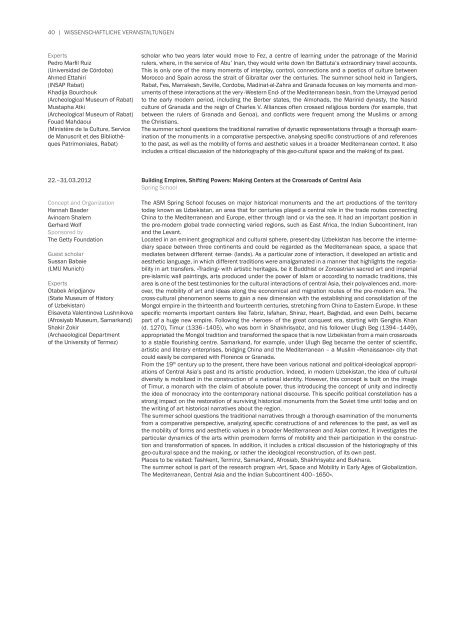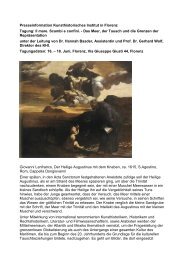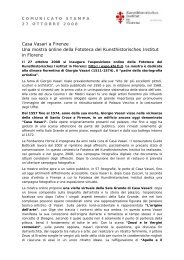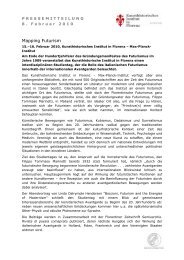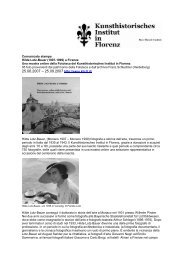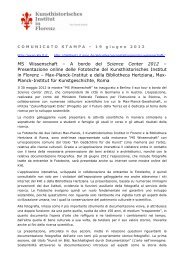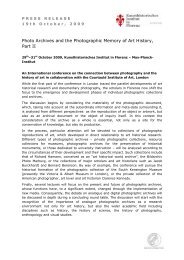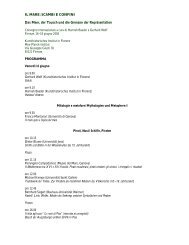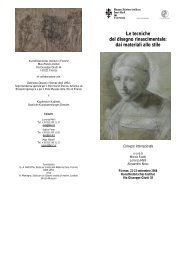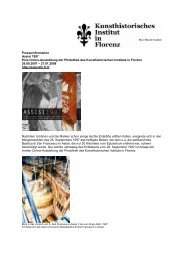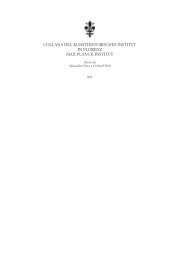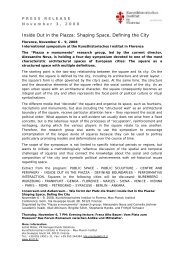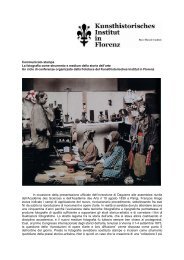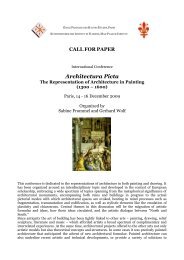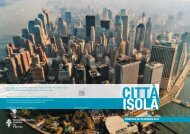juli 2012 - Kunsthistorisches Institut in Florenz
juli 2012 - Kunsthistorisches Institut in Florenz
juli 2012 - Kunsthistorisches Institut in Florenz
You also want an ePaper? Increase the reach of your titles
YUMPU automatically turns print PDFs into web optimized ePapers that Google loves.
40 | WISSENSCHAFTLICHE VERANSTALTUNGEN<br />
Experts<br />
Pedro Marfil Ruiz<br />
(Universidad de Córdoba)<br />
Ahmed Ettahiri<br />
(INSAP Rabat)<br />
Khadija Bourchouk<br />
(Archeological Museum of Rabat)<br />
Mustapha Atki<br />
(Archeological Museum of Rabat)<br />
Fouad Mahdaoui<br />
(M<strong>in</strong>istère de la Culture, Service<br />
de Manuscrit et des Bibliothèques<br />
Patrimoniales, Rabat)<br />
scholar who two years later would move to Fez, a centre of learn<strong>in</strong>g under the patronage of the Mar<strong>in</strong>id<br />
rulers, where, <strong>in</strong> the service of Abu’ Inan, they would write down Ibn Battuta’s extraord<strong>in</strong>ary travel accounts.<br />
This is only one of the many moments of <strong>in</strong>terplay, control, connections and a poetics of culture between<br />
Morocco and Spa<strong>in</strong> across the strait of Gibraltar over the centuries. The summer school held <strong>in</strong> Tangiers,<br />
Rabat, Fes, Marrakesh, Seville, Cordoba, Mad<strong>in</strong>at-al-Zahra and Granada focuses on key moments and monuments<br />
of these <strong>in</strong>teractions at the very ›Western End‹ of the Mediterranean bas<strong>in</strong>, from the Umayyad period<br />
to the early modern period, <strong>in</strong>clud<strong>in</strong>g the Berber states, the Almohads, the Mar<strong>in</strong>id dynasty, the Nasrid<br />
culture of Granada and the reign of Charles V. Alliances often crossed religious borders (for example, that<br />
between the rulers of Granada and Genoa), and conflicts were frequent among the Muslims or among<br />
the Christians.<br />
The summer school questions the traditional narrative of dynastic representations through a thorough exam<strong>in</strong>ation<br />
of the monuments <strong>in</strong> a comparative perspective, analys<strong>in</strong>g specific constructions of and references<br />
to the past, as well as the mobility of forms and aesthetic values <strong>in</strong> a broader Mediterranean context. It also<br />
<strong>in</strong>cludes a critical discussion of the historiography of this geo-cultural space and the mak<strong>in</strong>g of its past.<br />
22.–31.03.<strong>2012</strong><br />
Concept and Organization<br />
Hannah Baader<br />
Av<strong>in</strong>oam Shalem<br />
Gerhard Wolf<br />
Sponsored by<br />
The Getty Foundation<br />
Guest scholar<br />
Sussan Babaie<br />
(LMU Munich)<br />
Experts<br />
Otabek Aripdjanov<br />
(State Museum of History<br />
of Uzbekistan)<br />
Elisaveta Valent<strong>in</strong>ova Lushnikova<br />
(Afrosiyab Museum, Samarkand)<br />
Shakir Zokir<br />
(Archaeological Department<br />
of the University of Termez)<br />
Build<strong>in</strong>g Empires, Shift<strong>in</strong>g Powers: Mak<strong>in</strong>g Centers at the Crossroads of Central Asia<br />
Spr<strong>in</strong>g School<br />
The ASM Spr<strong>in</strong>g School focuses on major historical monuments and the art productions of the territory<br />
today known as Uzbekistan, an area that for centuries played a central role <strong>in</strong> the trade routes connect<strong>in</strong>g<br />
Ch<strong>in</strong>a to the Mediterranean and Europe, either through land or via the sea. It had an important position <strong>in</strong><br />
the pre-modern global trade connect<strong>in</strong>g varied regions, such as East Africa, the Indian Subcont<strong>in</strong>ent, Iran<br />
and the Levant.<br />
Located <strong>in</strong> an em<strong>in</strong>ent geographical and cultural sphere, present-day Uzbekistan has become the <strong>in</strong>termediary<br />
space between three cont<strong>in</strong>ents and could be regarded as the Mediterranean space, a space that<br />
mediates between different ›terrae‹ (lands). As a particular zone of <strong>in</strong>teraction, it developed an artistic and<br />
aesthetic language, <strong>in</strong> which different traditions were amalgamated <strong>in</strong> a manner that highlights the negotiability<br />
<strong>in</strong> art transfers. »Trad<strong>in</strong>g« with artistic heritages, be it Buddhist or Zoroastrian sacred art and imperial<br />
pre-islamic wall pa<strong>in</strong>t<strong>in</strong>gs, arts produced under the power of Islam or accord<strong>in</strong>g to nomadic traditions, this<br />
area is one of the best testimonies for the cultural <strong>in</strong>teractions of central Asia, their polyvalences and, moreover,<br />
the mobility of art and ideas along the economical and migration routes of the pre-modern era. The<br />
cross-cultural phenomenon seems to ga<strong>in</strong> a new dimension with the establish<strong>in</strong>g and consolidation of the<br />
Mongol empire <strong>in</strong> the thirteenth and fourteenth centuries, stretch<strong>in</strong>g from Ch<strong>in</strong>a to Eastern Europe. In these<br />
specific moments important centers like Tabriz, Isfahan, Shiraz, Heart, Baghdad, and even Delhi, became<br />
part of a huge new empire. Follow<strong>in</strong>g the »heroes« of the great conquest era, start<strong>in</strong>g with Genghis Khan<br />
(d. 1270), Timur (1336–1405), who was born <strong>in</strong> Shakhrisyabz, and his follower Ulugh Beg (1394–1449),<br />
appropriated the Mongol tradition and transformed the space that is now Uzbekistan from a ma<strong>in</strong> crossroads<br />
to a stable flourish<strong>in</strong>g centre. Samarkand, for example, under Ulugh Beg became the center of scientific,<br />
artistic and literary enterprises, bridg<strong>in</strong>g Ch<strong>in</strong>a and the Mediterranean – a Muslim »Renaissance« city that<br />
could easily be compared with Florence or Granada.<br />
From the 19 th century up to the present, there have been various national and political-ideological appropriations<br />
of Central Asia’s past and its artistic production. Indeed, <strong>in</strong> modern Uzbekistan, the idea of cultural<br />
diversity is mobilized <strong>in</strong> the construction of a national identity. However, this concept is built on the image<br />
of Timur, a monarch with the claim of absolute power, thus <strong>in</strong>troduc<strong>in</strong>g the concept of unity and <strong>in</strong>directly<br />
the idea of monocracy <strong>in</strong>to the contemporary national discourse. This specific political constellation has a<br />
strong impact on the restoration of surviv<strong>in</strong>g historical monuments from the Soviet time until today and on<br />
the writ<strong>in</strong>g of art historical narratives about the region.<br />
The summer school questions the traditional narratives through a thorough exam<strong>in</strong>ation of the monuments<br />
from a comparative perspective, analyz<strong>in</strong>g specific constructions of and references to the past, as well as<br />
the mobility of forms and aesthetic values <strong>in</strong> a broader Mediterranean and Asian context. It <strong>in</strong>vestigates the<br />
particular dynamics of the arts with<strong>in</strong> premodern forms of mobility and their participation <strong>in</strong> the construction<br />
and transformation of spaces. In addition, it <strong>in</strong>cludes a critical discussion of the historiography of this<br />
geo-cultural space and the mak<strong>in</strong>g, or rather the ideological reconstruction, of its own past.<br />
Places to be visited: Tashkent, Term<strong>in</strong>z, Samarkand, Afrosiab, Shakhrisyabz and Bukhara.<br />
The summer school is part of the research program »Art, Space and Mobility <strong>in</strong> Early Ages of Globalization.<br />
The Mediterranean, Central Asia and the Indian Subcont<strong>in</strong>ent 400–1650«.


